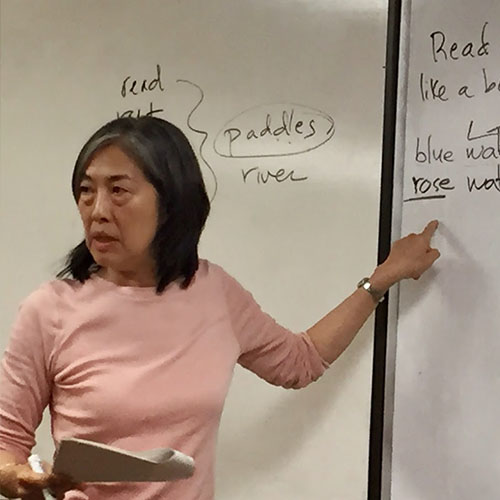Visiting Poets
Cathy Song
A native of Wahiawa, Hawaii and of Chinese and Korean descent, Cathy Song‘s first volume of poetry, Picture Bride, won the 1982 Yale Series of Younger Poets Award and was nominated for the 1983 National Book Critics Circle Award. She has since written two other volumes of poetry, Frameless Windows, Squares of Light (1988), and School Figures (1994).
Her narrative poetry has been compared to “flowers: colorful, sensual and quiet… offered almost shyly as bouquets to those moments in life that seemed minor but in retrospect count the most” by Richard Hugo. Song’s focus on family, tradition, and community have been described by Asian American Literature as “the complete fusion of form, image, occasion, and emotion… a sudden eruption of metaphor, which startles, teases, illuminates.”
Though her volumes of poetry capture a unique immigrant experience that straddles Asia-Pacific and America, Song has consistently maintained that the rich world within her poems transcend her own ethnic and regional background, calling herself “a poet who happens to be Asian-American” and resisting classification as an “Asian-American” or “Hawaiian” writer.
Song currently teaches at the University of Hawaii at Manoa, and works as an editor for Bamboo Ridge Press. Her poems have appeared in an anthology of asian-pacific literature, and in Dark Horse, The Greenfield Review, and West Branch.
Select Poems
from a uiyo-e print by Utamaro
The light is the inside
sheen of an oyster shell,
sponged with the talc and vapor,
moisture from a bath.
A pair of slippers
are placed outside
the rice-paper doors.
she kneels at a low table
in the room,
her legs folded beneath her
as she sits on a buckwheat pillow.
Her hair is black
with hints of red,
the color of seaweed
spread over rocks.
Morning begins the ritual
wheel of the body,
the application of translucent skins.
She practices pleasure:
the pressure of three fingertips
applying powder.
Fingerprints of pollen
some other hand will trace.
The peach-dyed kimono
patterned with maple leaves
drifting across the silk,
falls from right to left
in a diagonal, revealing
the nape of her neck
and the curve of a shoulder
like the slope of a hill
set deep in snow in a country
of huge white solemn birds.
Her face appears in the mirror,
a reflection in a winter pond,
rising to meet itself.
She dips a corner of her sleeve
like a brush into water
to wipe the mirror;
she is about to paint herself.
The eyest narrow
in a moment of self-scrutiny.
The mouth parts
as if desiring to disturb
the placid plum face;
break the symmetry of silence.
But the berry-stained lips,
stenciled into the mask of beauty,
do not speak.
Two chrysanthemums
touch in the middle of the lake and drift apart.
From PICTURE BRIDE (Yale University Press, 1983)
She was a year younger
than I,
twenty-three when she left Korea.
Did she simply close
the door of her father’s house
and walk away. And
was it a long way
through the tailor shops of Pusan
to the wharf where the boat
waited to take her to an island
whose name she had
only recently learned,
on whose shore
a man waited,
turning her photograph
to the light when the lanterns
in the camp outside
Waialua Sugar Mill were lit
and the inside of his room
grew luminous
from the wings of moths
migrating out of the cane stalks?
What things did my grandmother
take with her? and when
she arrived to look
into the face of the stranger
who was her husband,
thirteen years older than she,
did she politely untie
the silk bow of her jacket,
her tent-shaped dress
filling with the dry wind
that blew from the surrounding fields
where the men were burning the cane?
From PICTURE BRIDE (Yale University Press, 1983)
His hair is brilliantined.
It is black and shiny
like patent leather.
Se cannot be more than twenty:
his cheeks are full,
his face is smooth as a baby’s,
though one pockmark
above his right temple
about the size of a rice kernel
is detectable.
His mouth appears to be
curved over something almond shaped.
Perhaps, he is sucking on a sweet plum.
His suit is puckered
at the seams.
The shoulders are too narrow,
fitting badly;
probably stitched
in a lamplit tailor shop
hovering in a back alley.
But the necktie adds
the texture of raw silk;
the added touch signifying
that this is meant to be
a serious picture;
the first important photograph
he has ever had taken.
This will document
his passage out
of the deteriorating village.
He will save it
to show his grandchildren.
As if already imagining them,
his eyes are luminous.
He is looking ahead,
beyond the photographer
in the dark room
crouched under the black velvet cloth,
beyond the noisy cluttered streets
pungent with garlic and smoke chestnuts.
Rinsing through his eyes
and dissolving all around him
is sunlight on water.
From PICTURE BRIDE (Yale University Press, 1983)

